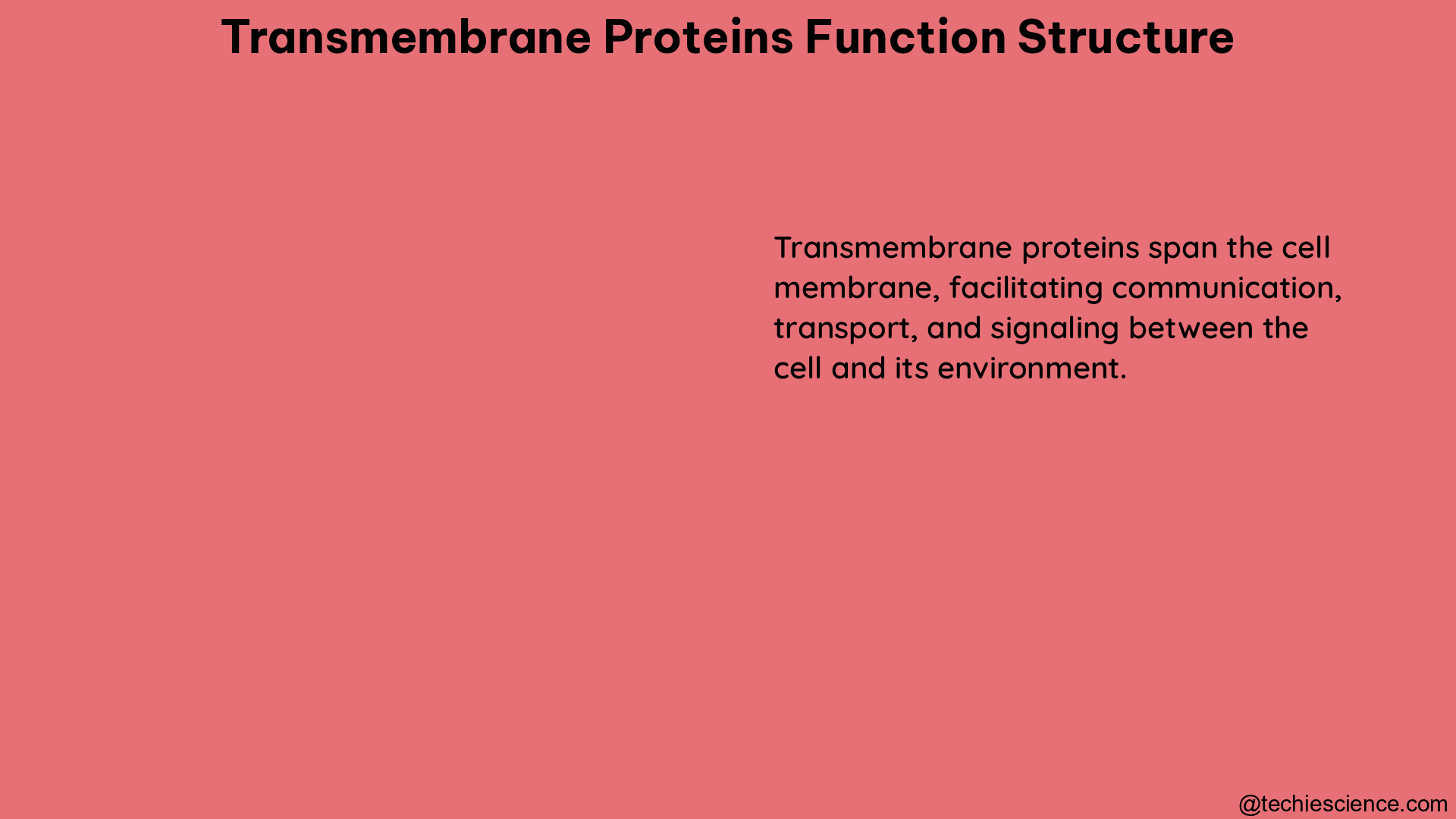Transmembrane proteins (TMPs) are essential components of the cell membrane, playing crucial roles in various biological processes, such as signal transduction, molecular transport, and cell adhesion. These proteins span the lipid bilayer, with hydrophobic regions interacting with the lipid tails and hydrophilic regions interacting with the aqueous environment on either side of the membrane.
Structure of Transmembrane Proteins
TMPs can be classified into three main categories based on their structural characteristics:
-
α-helical TMPs: These proteins contain several hydrophobic α-helices that traverse the lipid bilayer. The α-helices are stabilized by hydrogen bonds between the carbonyl and amino groups of the peptide backbone. Examples of α-helical TMPs include G protein-coupled receptors (GPCRs) and ion channels.
-
β-barrel TMPs: These proteins consist of antiparallel β-strands that form a barrel-shaped structure. The β-strands are connected by loops and turns, and the barrel is stabilized by hydrogen bonds between the β-strands. Examples of β-barrel TMPs include bacterial outer membrane proteins and some eukaryotic membrane proteins.
-
Multi-spanning TMPs: These proteins contain a combination of α-helical and β-barrel domains, allowing for a more complex and diverse range of structures and functions. Examples of multi-spanning TMPs include transporters and channels that facilitate the movement of molecules across the cell membrane.
Function of Transmembrane Proteins

TMPs play a crucial role in various biological processes, including:
- Signal Transduction:
- G Protein-Coupled Receptors (GPCRs): These TMPs bind to extracellular ligands and activate intracellular signaling pathways, mediating a wide range of physiological responses, such as vision, olfaction, and neurotransmission.
-
Ion Channels: These TMPs allow the flow of ions (e.g., Na+, K+, Ca2+, Cl-) across the cell membrane in response to various stimuli, such as changes in membrane potential, ligand binding, or mechanical stress. Ion channels are essential for nerve impulse propagation, muscle contraction, and other cellular processes.
-
Molecular Transport:
- Transporters: These TMPs bind to specific substrates (e.g., ions, small molecules, macromolecules) and facilitate their movement across the cell membrane, either actively (against a concentration gradient) or passively (down a concentration gradient).
-
Channels: These TMPs allow the passive flow of ions or small molecules across the cell membrane, driven by concentration or electrochemical gradients.
-
Cell Adhesion:
- Cadherins: These TMPs mediate homophilic interactions between cells, forming cell-cell adhesion complexes that are crucial for tissue integrity and development.
- Integrins: These TMPs bind to extracellular matrix proteins and mediate cell-matrix adhesion, which is essential for cell migration, signaling, and survival.
Biological Specification of Transmembrane Proteins
Transmembrane proteins are encoded by approximately 30% of the human genome, highlighting their importance in biological systems. Mutations in TMPs can lead to various diseases, including cancer, neurological disorders, and cardiovascular diseases. Understanding the structure and function of TMPs is crucial for developing targeted therapeutic strategies.
Advanced Hands-On Techniques for Studying Transmembrane Proteins
Several experimental and computational methods have been developed to study the structure and function of TMPs:
-
X-ray Crystallography: This technique uses the diffraction of X-rays by the atoms in a crystallized protein sample to determine its three-dimensional structure at high resolution. It has been used to elucidate the structures of numerous TMPs, such as the human α4β2 nicotinic receptor.
-
Nuclear Magnetic Resonance (NMR) Spectroscopy: NMR spectroscopy can provide information about the structure, dynamics, and interactions of TMPs in solution or in lipid bilayer environments. It is particularly useful for studying the structure and function of smaller TMPs.
-
Cryogenic Electron Microscopy (cryo-EM): This technique uses low-temperature electron microscopy to capture high-resolution images of TMPs in their native state, without the need for crystallization. It has been used to determine the structure of human aquaporin 4, a water channel.
-
Molecular Dynamics (MD) Simulations: Computational methods, such as MD simulations, can provide insights into the dynamic behavior of TMPs, including their conformational changes, interactions with ligands, and transport mechanisms. These simulations can complement experimental data and help elucidate the underlying mechanisms of TMP function.
By combining these advanced techniques, researchers can gain a comprehensive understanding of the structure, function, and dynamics of transmembrane proteins, which is crucial for developing targeted therapeutic strategies and advancing our knowledge of cellular processes.
References:
- Li Fei, Egea Pascal F., Vecchio Alex J., Asial Ignacio, Gupta Meghna, Paulino Joana, Bajaj Ruchika, Dickinson Miles, Ferguson-Miller Sasha, Monk Shelagh, Stroud Brian C., and M. Robert. “Highlighting membrane protein structure and function: A celebration of the Protein Data Bank.” Journal of Biological Chemistry 296, no. 14 (2021): 4517-4532.
- Mesdaghi Shahram, Murphy David L., Sánchez Rodríguez Filomeno, Burgos-Mármol J. Javier, and Rigden Daniel J. “In silico prediction of structure and function for a large family of transmembrane proteins that includes human Tmem41b.” Bioinformatics 36, no. 15 (2020): 4275-4283.
- Cournia Zoe, Allen Toby W., Andricioaei Ioan, Antonny Bruno, Baum Daniel, Brannigan Grace, Buchete Nicolae-Viorel, Deckman Jason T., Delemotte Lucie, del Val Coral, Friedman Ran, Gkeka Paraskevi, Hege Hans-Christian, Hildebrand Jörg, Hodoscek Robert, Huang Zhong, Jensen Mogens, Khalili-Araghi Fereshteh, Kofke David A., Kukic Pavao, Lange Martin, Lee Hyun-Dong, Li Xiaohui, Liu Jun, Luo Rui, Ma Jian, Mamonov Alexander, Mamonova Elena, Meng Yu, Miao Guang, Miyashita Koji, Miyoshi Hiroshi, Mobley David L., Moriya Yoshitaka, Moult John, Nussinov Ruth, Okazaki Hiroshi, Pande Vasudev, Pantano Corrado, Pellegrini-Calace Marina, Perilla Juan R., Poger Derek, Popovych Nelya, Rao Yi, Ribeiro de Almeida A., Ripoll Daniel, Rosenthal Sarel, Sansom Michael S. P., Schug A., Shi L., Shoemaker Brian A., Simmerling Christian, Skjevik Åsmund, Song Chang-Shung, Srinivasan Jai, Stansfeld P., Strodel Brian, Su Xueyi, Tajkhorshid E., Tieleman D., Trabuco Leonardo G., Vacha Frantisek, Vogel Alexander, Wang Jian, Wang Wei, Wang Yihan, Wang Ying, Woolf T. B., Xu Haiming, Yang Liu, Yonezawa Yoshihiro, Zhang C., Zhang J., Zhang M., Zhang Y., Zhou R., Zhu Xuefei, Zhuo Jian, and Zou Jian. “Membrane Protein Structure, Function and Dynamics.” Biophysical Journal 108, no. 3 (2015): 505-524.
Hi….I am Ashish Nandal, I have completed my Master’s in Biotechnology. I always like to explore new areas in the field of Biotechnology.
Apart from this, I like to read, travel, and photography.